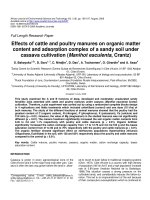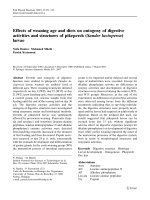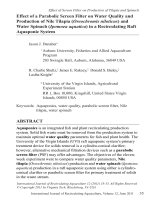Pathogenicity of root-knot nematode (Meloidogyne incognita) on Ivy gourd (Coccinia indica L.)
Bạn đang xem bản rút gọn của tài liệu. Xem và tải ngay bản đầy đủ của tài liệu tại đây (986.74 KB, 7 trang )
Int.J.Curr.Microbiol.App.Sci (2020) 9(5): 929-935
International Journal of Current Microbiology and Applied Sciences
ISSN: 2319-7706 Volume 9 Number 5 (2020)
Journal homepage:
Original Research Article
/>
Pathogenicity of Root-knot Nematode (Meloidogyne incognita) on
Ivy Gourd (Coccinia indica L.)
Bidisha Sonowal*, Bornali Mahanta and Aprajita Borah
Department of Nematology, Assam Agricultural University, Jorhat, Assam- 785013, India
*Corresponding author
ABSTRACT
Keywords
Meloidogyne
incognita, Ivy
gourd,
pathogenicity
Article Info
Accepted:
05 April 2020
Available Online:
10 May 2020
An experiment was carried out in the net house of department of Nematology, Assam Agricultural
University, Jorhat during rabi season 2017 to study the pathogenicity of Meloidogyne incognita on
Coccinia indica. For that local variety of Ivy gourd cuttings were planted in 1kg capacity pot filled
with sterilized soil. One-month old cuttings were inoculated with second stage juvenile of M.
incognita in a logarithmic series of check, associated check, 10, 100, 1000, 10,000 juveniles (J 2) per
pot. The plants were watered regularly. After 45 days of incubation it was observed that at highest
inoculum level plants were very much stunted, chlorotic and with very few branches. Further, it was
observed that at the highest inoculum level, root systems were very much reduced with the galls
which were bigger in size and mostly coalescent in the roots. The treatment with no nematode
(Check and associated check) was free from galls and eggmasses. The observations on the plant
growth parameters like plant height, shoot and root weight (fresh and dry) were decreased
progressively from initial inoculum level of 100 to highest inoculum level of 10,000 J2per pot but the
nematode multiplications like number of galls per root, eggmasses per root and final nematode
population in soil were increased gradually with increase in inoculum level from 10 to 1000J 2 per
pot, but it declined at 10,000J2 inoculum level per pot. Further, it was found that there was no
significant difference in plant growth parameters like plant height, shoot and root weight (fresh and
dry) and nematode multiplications like number of galls per root, eggmasses per root and final
nematode population in soil among the treatments with no nematode i.e Check and associated Check.
Moreover, it was observed that there was no significant difference for galls per root, eggmasses per
root and final nematode population in soil in between the treatments with 10 and 10,000J2 per pot.
Karnataka, Maharashtra, Bihar, Andhra
Pradesh and Gujarat. The Cucurbitaceae
family ranks among the highest of plant
families for number and percentage of species
used as human food. Cucurbits share about
5.6% of the total vegetable production of
India and according to FAO estimate,
cucurbits were cultivated on about 4,290,000
ha with the productivity of 10.52t/ha.
Introduction
Ivy gourd, (Coccinia indica L.) is a tropical
perennial plant and belongs to the family,
Cucurbitaceae. Ivy gourd is also known as
baby watermelon, little gourd and popularly
known as Tondil/Kundru in India. It is known
as ‘Kunduli” in Assam. In India, it is widely
grown in Tamil Nadu, Assam, West Bengal,
929
Int.J.Curr.Microbiol.App.Sci (2020) 9(5): 929-935
Ivy gourd is mostly termed as poor man’s
vegetable (Singh and Singh, 2014). It is a
good source of Vitamin A, Beta-carotene,
iron, fiber and a good source of protein. Yield
of C. indica affected due to pest and disease.
Among them, root knot nematodes
Meloidogyne incognita produces galls on the
root and known as root knot disease due to
amalgamation of a number of galls. In
general, M. incognita produces egg masses on
galls and it contains more that 250-500 eggs.
Such reproductions are governed by many
factors like susceptible host, nematode
inoculum
density
and
environmental
conditions. Our main aim is to reduce the
inoculum density of pathogen at below
economic injury level. So, it is important to
conduct a study on the inoculum density of
pathogen against a susceptible host under
controlled condition and it helps in
formulating the integrated management of
that particular pathogen. Keeping this in view
an experiment was carried out on
pathogenicity of M. incognita on C. indica
inoculation. Plant heights were recorded
before uprooting the plants. Number of galls
and egg masses per root system were
recorded. Similarly, fresh weight of shoot and
roots were taken. For recording dry weight,
the plants along with their root systems were
packed in a paper bags and kept in an oven at
60°C till constant weight of dried plant
materials were obtained. The nematode
population in the pot soil was determined by
washing 200cc of homogenously mixed pot
soil by Cobb’s Modified sieving and
decanting technique (Christie and Perry,
1951). Statistical analysis was performed by
using SAS 1.0 software.
Results and Discussion
The data on pathogenicity of rootknotnematode, M. incognita on growth and
development of Ivy gourd were presented in
Table 1 and 2, Figures 1, 2and 3. After 45
days of incubation it was observed that there
was a progressive decrease in all plant growth
parameters of Ivy gourd with the increasing
inoculum level of M incognita from 10 to
10,000 (J2) second stage juveniles per pot
containing 1kg of sterilized soil. At the
highest inoculum level plants were very much
stunted, chlorotic and with very few branches.
It was further observed that at the highest
inoculum level, root systems were very much
reduced with the galls which were bigger in
size and mostly coalescent in the roots. The
treatment with no nematode (Check and
associated check) was free from galls and
eggmasses. The observations on the plant
growth parameters like plant height, shoot and
root weight (fresh and dry) were decreased
progressively from initial inoculum level of
100 to highest inoculum level of 10,000 J2per
pot. However, the highest reduction i.e13.00
percent of plant growth parameters like plant
height shoot and root weight (fresh and dry)
was observed in inoculum level of 10,000 J2
per pot.
Materials and Methods
The experiment was carried out in the net
house of Department of Nematology, Assam
Agricultural University, Jorhat during rabi
season 2017 to study the pathogenicity of M.
incognita on Ivy gourd. Required quantities of
earthen pots were collected, filled with 1kg of
autoclaved soil and labeled according to the
allotted treatments and replications. Local
variety of Ivy gourd cuttings were planted in
1kg capacity pot filled with sterilized soil.
The pots were arranged in completely
randomized design (CRD) with 5 replications
for each treatment. One-month old cuttings
were inoculated with second stage juvenile of
M. incognita in a logarithmic series of check,
associated check, 10, 100, 1000, 10,000
juveniles (J2) per pot. The plants were
watered regularly. Observations on different
plant parameters were taken after 45 days of
930
Int.J.Curr.Microbiol.App.Sci (2020) 9(5): 929-935
Further, it was found that there was no
significant difference in plant height, plant
height, shoot and root weight (fresh and dry)
among the treatments with no nematode
(Check and associated Check) and 10 J2 per
pot but the treatments having 100, 1000 and
10,000 J2 per pot differed significantly from
each other in plant height, plant height, shoot
and root weight (fresh and dry), respectively.
Similarly,
in
respect
of
nematode
multiplications, it was observed that the
number of galls per root, eggmasses per root
and final nematode population in soil were
increased gradually with increase in inoculum
level from 10 to 1000J2 per pot, but it
declined at 10,000 inoculum level per pot.
Further, it was observed that there was a
significant reduction in plant height of Ivy
gourd at and above 100 nematodes per pot.
Similar results were obtained by Bharali
(1996) on cucumber, Savitri (2006) on Ash
gourd. The growth parameters of the crop
were severely affected with increasing
inoculum levels of the nematode which might
be due to the destruction of the root system
which ultimately affected the nutrient and
water uptake. There was a corresponding
reduction in fresh and dry weight of shoot of
the plants with increase in level of inoculum
from 10 to 10,000 nematodes per pot. Similar
results were reported by Gupta et al., (1999)
on bitter gourd in case of M.javanica,
Mahapatra et al., (1999) on pointed gourd,
Singh (2011) on bottle gourd. The results
further revealed that there was a progressive
decrease in root weight (fresh and dry) as the
inoculum level of Meloidogyne incognita
increased. This finding is in conformity with
that of Bharali (1996) who reported
significant reduction in fresh and dry root
weight on cucumber, Mahapatra et al., (1999)
on pointed gourd, Savitri (2006) on Ash
gourd.
The maximum number of galls per root,
eggmasses per root and final nematode
population in soil were recorded in the
inoculum level 1000 J2 per pot while the
minimum galls per root, eggmasses per root
and final nematode population in soil were
recorded in the treatment with 10,000 and
100J2 per pot. Further, it was observed that
there was no significant difference for galls
per root, eggmasses per root and final
nematode population in soil in between the
treatments with 10 and 10,000J2per pot but
these treatments differed significantly from
the treatments with 100 and 1000 J2 per pot,
respectively.
Further, it was observed that the plants at
highest inoculum level (10,000 nematodes per
pot) had a poor stand, root system was very
much reduced and feeder roots were
completely absent. Similar results were
reported by Dhankar et al., (1986) on
watermelon, Bharali (1996) on cucumber.
There was a progressive increase in number
of galls and eggmasses with increase in
inoculum level from 10 to 1000 and declined
at 10,000 inoculum level per pot. Similar
findings were obtained by Paruthi and Gupta
(1985) on bottle gourd, Dhankar et al., (1986)
on watermelon, Bharali (1996) on cucumber.
There was a progressive increase in nematode
population in pot soil with the increase in
inoculum level from 10 to 10,000 nematodes
per pot.
Discussion
The results obtained in the study of
pathogenicity of root-knot nematode M.
incognita on Ivy gourd indicated that plants
became stunted with the increase of inoculum
level of nematode population. This finding is
in agreement with the findings obtained by
Sable and Darekar (1985) on bitter gourd,
Dhankar et al., (1986) on watermelon, Similar
findings had also been recorded by Savitri
(2006) on Gherkin (small variety of
cucumber) and Ash gourd, Singh (2011) on
bottle gourd.
931
Int.J.Curr.Microbiol.App.Sci (2020) 9(5): 929-935
Table.1 Effect of different inoculum levels of Meloidogyne incognita on plant growth
parameters of Ivy gourd (Mean of 5 replications)
Inoculum level
(J2/kg soil)
T1:Check
T2:Associated check
T3:10
T4:100
T5:1000
T6:10,000
S.Ed.(±)
CD0.05
Plant
height
(cm)
89.18a
88.78a
85.98a
57.98b
42.50c
22.36d
1.61
3.33
Fresh
weight of
shoot (g)
20.02a
19.56a
15.16b
15.06b
10.08c
7.18d
1.11
2.29
Dry
weight of
shoot (g)
3.44a
3.10a
2.84a
2.06b
1.60c
1.08d
0.20
0.41
Fresh
weight of
root (g)
11.04a
10.28a
10.16a
8.36b
6.72c
4.92d
0.60
1.25
Dry
weight of
root (g)
2.38a
2.20a
1.56b
1.52b
1.09c
0.77d
0.13
0.28
*Mean followed by the same letter in the superscript(s) are statistically at par
Table.2 Effect of different inoculum levels of Meloidogyne incognita on number of galls,
eggmasses and nematode population on Ivy gourd. (Mean of 5 replications)
Inoculum level
(J2/kg soil)
T1:Check
T2:Associated check
T3:10
T4:100
T5:1000
T6:10,000
S.Ed.(±)
CD0.05
No.of
galls/
root
system
No.ofeggm
asses / root
system
Final nematode
population (200
cc of soil)
Reproducti
ve rate (%)
0.00
(0.70)d
0.00
(0.70)d
34.00
(5.86)c
112.4
(10.61)b
158.2
(12.58)a
31.60
(5.62)c
0.14
0.30
0.00
(0.70)d
0.00
(0.70)d
20.20
(4.53)c
35.40
(5.97)b
68.60
(8.30)a
17.60
(4.24)c
0.16
0.34
0.00
(0.70)d
0.00
(0.70)d
333.96
(18.14)c
1175.94
(34.18)b
2832.00
(52.97)a
3096.00
(55.52)a
2.01
4.16
0.00
0.00
33.39
11.75
2.83
0.30
Values of number of galls, eggmasses and final nematode population within parentheses are square root
(
x + 0.5 ) transformed data. Mean followed by the same letter in the superscript(s) are statistically at par.
932
Pathogenicity of root-knot
Int.J.Curr.Microbiol.App.Sci (2020) 9(5): 929-935
nematode (Meloidogyne
incognita)
on Ivy gourd (Coccinia indica L.)
Pathogenicity of root-knot
nematode (Meloidogyne incognita)
on Ivy gourd (Coccinia indica L.)
10,000
1000
10,000
1000
100
10
100
10
ASSOCIATED
CHECK
ASSOCIATED
CHECK
CHECK
CHECK
Figure 1. General view of the pot experiment on Ivy gourd
Fig.1 General View of the pot-experiment on Ivy gourd
Figure 1. General view of the pot experiment on Ivy gourd
CHECK
ASSOCIATED
CHECK
10
100
1000
10,000
ASSOCIATED
CHECK
10 different
100
Figure 2. Growth of Ivy gourd under
inoculum1000
levels of Meloidogyne
10,000
CHECK
incognita
Fig.2 Growth of Ivy gourd under different inoculum levels of Meloidogyne incognita
Figure
2. Growth of Ivy gourd under different inoculum levels of Meloidogyne
incognita
933
Int.J.Curr.Microbiol.App.Sci (2020) 9(5): 929-935
ASSOCIATED
CHECK
CHECK
10
100
10,000
1000
Fig.3 Effect
of3.different
inoculum
level
of Meloidogyne
incognita on incognita
root growth
Ivy gourd
Figure
Effect of
different
inoculum
level of Meloidogyne
onofroot
growth of Ivy gourd
A gradual increase in nematode population
with increase in inoculum level was reported
by Venkatesan (2009) on bitter gourd, Singh
(2011) on bottle gourd. The gradual increase
in nematode population results in gradual
decrease in reproductive rates. The maximum
(33.39) and minimum (0.30) reproductive rate
of nematodes were recorded in the lowest
inoculum level (10) and highest inoculum
level (10,000) per pot respectively. Highest
multiplication rate was recorded at lowest
inoculum level by Verma and Anwar (1995)
on pointed gourd, Singh (2011) on bottle
gourd. As suggested by Triantaphyllu and
Hirschmann (1960) variation in growth rate of
M. incognita is caused by competition for
food and overcrowding and development is
retarded where numerous larvae enter the
same root system.
934
Int.J.Curr.Microbiol.App.Sci (2020) 9(5): 929-935
Pathogenicity of Meloidogyne incognita
to bitter-gourd, Momordica charantia L.
Int. Nematol. Net. Newsl. 2(4): 13-14.
Savitri, D. (2006). Studies on root-knot
nematode, Meloidogyne spp. on
cucurbitaceous
vegetables.
M.Sc.
(Agri.)
Thesis
on
Nematology,
submitted to Acharya N.G. Ranga
Agricultural University, Hyderabad.
Singh, P.K. and Singh, M. (2014). Everyone’s
vegetable: Ivy gourd Kashi Bharpoor to
enrich vegetable basket.
Indian
Hort.59(2): 6-7.
Singh, T. (2011). Investigations on root-knot
nematodes (Meloidogyne spp.) on bottle
gourd. M.Sc. (Agri.) Thesis on
Nematology, submitted to Anand
Agricultural University, Anand.
Triantaphyllu, A.C. and Hirschmann, H.
(1960). Post-infection development of
Meloidogyne incognita Chitwood, 1949.
Ann. Inst. Phytopath. Benaki. N.S. 3: 111.
Venkatesan, M. (2009). Investigations on
root-knot nematodes (Meloidogyne
spp.) in bitter gourd. M.Sc. (Agri.)
Thesis on Nematology, submitted to
Anand Agricultural University, Anand.
Verma, A.C. and Anwar, A. (1995).
Pathogenicity of Meloidogyne incognita
in pointed gourd (Trichosan thesdioica).
Indian J. Mycol. Pl. Pathol. 25: 70.
References
Bharali, A. (1996). Pathogenicity and
management of Meloidogyne incognita
on cucumber. M.Sc. (Agri.) Thesis on
Nematology, submitted to Assam
Agricultural University, Jorhat.
Christie, J.R. and Perry, V.G. (1951).
Removing nematodes from soil. Proc.
Helminth Soc. Wash. 18: 106-108.
Dhankar, R. K.S., Sharma C., Sarna, N.T. and
Trivedi, P.C. (1986). Pathogenicity of
Meloidogyne incognita on watermelon
(Citrullus vulgarisScharad). Indian J. of
Nematol. 16 (2): 274.
Gupta, D.C.,Paruthi, I.J. and Jain, R.K.
(1999). Effect of initial inoculum levels
of Meloidogyne spp. on some
cucurbitaceous
crops.
Indian
J.
Nematol. 25(2): 194-199.
Mahapatra, S.N., Swain, P.K. and Behera, B.
(1999). Pathogenicity and management
of root-knot nematode (Meloidogyne
incognita) in pointed gourd (Trichosan
thesdioica). Indian J. Agric. Sci., 69:
275-277.
Paruthi, I.J. and Gupta, D.C. (1985).
Pathogenicity of root-knot nematode,
Meloidogyne javanica on bottle gourd
(Lagenaria siceraria) using two
methods of inoculation. Indian J.
Nematol. 15(1): 52-54.
Sable, A.N. and Darekar, K.S. (1985).
How to cite this article:
Bidisha Sonowal, Bornali Mahanta and Aprajita Borah. 2020. Pathogenicity of Root-knot
Nematode (Meloidogyne incognita) on Ivy Gourd (Coccinia indica L.).
Int.J.Curr.Microbiol.App.Sci. 9(05): 929-935. doi: />
935









